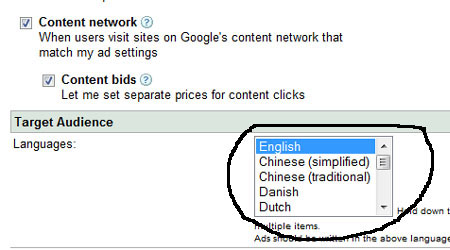 |
Today is the third day in our week long series on advanced PPC strategies. According to a Search Marketing Now webinar, 75% of the world’s searches are performed outside of North America. That’s a large number, which tells me there is a lot of opportunity to reach additional customers, to increase traffic, and revenue. Targeting outside North America does require a specific understanding of the localized markets in which you plan to expand. There are a few questions you need to answer before attempting to create an international targeted PPC campaign. In this post I’ll go over these questions and outline a few steps you should take when creating a successful multi-national PPC campaign.Is targeting internationally for you? This is the very first question you should ask yourself before attempting to set up your international campaigns. To fully answer this question, you need answer this series of questions:
- Do you offer shipping to the targeted areas or countries?
- Can you handle different currencies and taxes?
- Are your products allowed to be shipped to the target area?
- Do you have customer support staff that is available to speak the target areas language?
- Does your company employ a bi-lingual person or translator to help create keywords, ad text and landing pages?
If you can answer ‘yes’ to all of these questions it looks like you’re ready to get started with your international PPC campaign. Get to know your customers: The first step is to identify the countries or areas you wish to target. Does your product or service appeal to this particular group of people? What is the predominate language? Most importantly, make sure it makes sense to target a specific area before you take the time and money creating a PPC campaign. Find good translators: Search Marketing Now suggests that you get to know the local idioms and be able to translate unique or technical terms for your product service or brand. Another tip: you can’t just translate the English language word-for-word and expect it to make perfect sense in another language. You must know the ‘slang’ of that particular language and know when to begin and end sentences. Search Marketing Now suggests that you begin translating your keyword list first, then move onto to your landing page and ad texts. Use a country-specific domain: If you currently only have a ‘.com’ domain, consider getting a country-specific domain for your translated landing page. For example, your main ‘.com’ domain could be Amber.com, but your country specific domains could be ppchero.co.uk for the UK or ppchero.co.ja for Japan. More information on Spanish targeting in particular can be read here.Set your language targeting: This is a very important step when setting up your internationally targeted campaigns. Which ever country/language you are targeting, be sure to select that language in you campaign settings. To do this in Google simply click ‘edit settings’ at the campaign level, and under ‘Target Languages‘ select the language you wish to target. This will allow your PPC ads to show up in that countries’ Google search engine. See screen shot below: Targeting Internationally with Yahoo! is an entirely different beast. To learn about targeting in specific countries for Yahoo! you can click here.Take note that Google dominates the North America and European search markets, while Yahoo! mostly dominates the Asian market. Keep this in mind when you have your target location identified, it may be better to start off with one search engine just to get things moving. In conclusion, targeting your PPC ads internationally can help drive additional traffic and revenue to your company. It can also create additional brand awareness. Running a successful international campaign means having a deep understanding of localized markets and should be optimized for both language and culture. (Search Marketing Now.)
Targeting Internationally with Yahoo! is an entirely different beast. To learn about targeting in specific countries for Yahoo! you can click here.Take note that Google dominates the North America and European search markets, while Yahoo! mostly dominates the Asian market. Keep this in mind when you have your target location identified, it may be better to start off with one search engine just to get things moving. In conclusion, targeting your PPC ads internationally can help drive additional traffic and revenue to your company. It can also create additional brand awareness. Running a successful international campaign means having a deep understanding of localized markets and should be optimized for both language and culture. (Search Marketing Now.)



